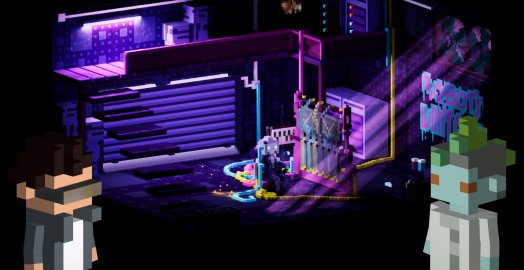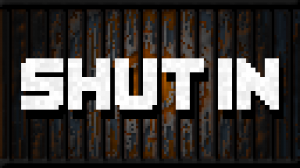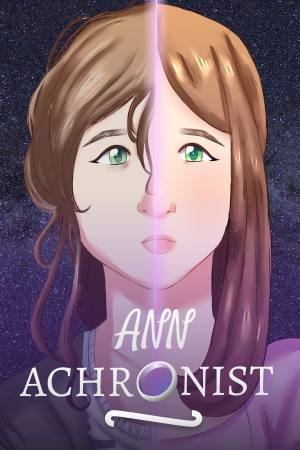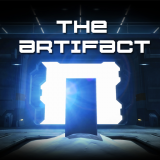Review for Oniria Crimes

While the walls don’t, strictly speaking, do any of the talking, Oniria Crimes gives whole new literal meaning to the expression “if these walls could talk,” with inanimate objects serving as witnesses to a series of crimes in the eponymous Land of Dreams. Although this third-person point-and-click mystery doesn’t quite live up to its potential, players who can handle a few frustrating puzzles and some trial-and-error elements will find an intriguing gameplay mechanic, various logic puzzles to solve, and a surprisingly rich backstory to discover, with myriad if somewhat overly brief glimpses of a voxel-based world beyond the six crime scenes they will be tasked with investigating over the course of the game’s 5-6 hours.
You’ll take on the role of detectives Santos and Torres, members of the Rounders, an organization that investigates crimes perpetrated in Oniria, a place where the shared experience of millions of lucid dreamers combines to create a living, breathing world highly reminiscent of MMOs like Second Life. The first elections in the history of Oniria are coming up soon, but a rash of serial killings threatens to destabilize peace in the capital in the run-up to election day. What’s more, the murders seem related to the political drama unfolding between the various Guilds of Oniria, which function in similar fashion to political parties, each having their own vision for the future of Oniria and its inhabitants. It is up to Santos and Torres to investigate the killer’s activities and, hopefully, bring him or her to justice before the vote gets underway.
I was immediately intrigued by the premise of Oniria Crimes, as the concept of a detective story taking place in a dream world seemed like relatively fresh territory for an adventure game plot to explore, and the objects-as-witnesses mechanic was likewise unusual. The way the story unfolds isn’t entirely new, of course, so anyone who has ever played, read, or watched a similar murder mystery will find plenty of familiar hallmarks of the genre, including clues and a gallery of suspects for the various crimes you’ll be tasked with investigating, as well as misdirection and red herrings that seem to be important but will ultimately lead you astray as you try to gather evidence.
What I wasn’t prepared for is just how much lore and backstory there is to be discovered, and in many ways the game’s greatest narrative strength is how fleshed out its world is. In the course of examining crime scenes and taking testimony from the objects you encounter, various aspects of life in Oniria are revealed, from its history and founding documents to the rather fraught relations between lucid dreamers and the indigenous inhabitants of the Land of Dreams, as well as aspects of Onirian culture like art, music, and literature. There are even hints of not-so-positive developments occurring due to such large numbers of people spending so much time in Oniria, neglecting the waking world.
Details like these are sometimes integral to the plot itself, and sometimes are simply additional flavor imparted through comments made by the objects you interrogate, and I found myself looking forward to exploring as much of each scene as possible in the hope of gleaning some new interesting tidbit of information about Oniria and its people. A wealth of references to both high- and pop-cultural works of art are also found throughout the game, providing fun moments when I spotted them. As most of the lore comes courtesy of the rather brief testimonials extracted from the range of objects encountered, however, I did find myself somewhat disappointed that the backstory tends to favor breadth over depth.
Though the world itself feels alive, unfortunately the central mystery around which the game revolves didn’t capture as much of my interest. One problem is that, while serving up appropriate twists and turns as the plot advances, the stakes involved in solving the crimes, ranging from serial murders to theft, never seemed especially urgent. While part of this disconnect can be blamed on the rather outlandish concept of committing murders in dreams, making me wonder initially what possible consequences one might suffer aside from waking up, the potential real-world consequences of one’s oneiric body being killed, as well as the importance of this particular crime spree, ended up being explained adequately. Even so, I never felt a particular emotional connection to the overarching case or its resolution, in stark contrast to the overall positive reaction I had to the concept of Oniria itself.
This can’t really be blamed on the script, however. The writing, dialogue, and cast are all handled well, with the attitudes and personalities of each character coming through clearly, despite the complete lack of voice-overs. In addition to the various human (and humanoid) people you will encounter, the individual objects in each scene have their own personalities as well, which can limit what they can tell you or influence the potential trustworthiness of them as witnesses. For instance, a mirror might only be able to describe what was directly in front of it at the time of the crime, while a flower might have a positive impression of a suspect who cared for it.
Oniria Crimes features an impressively diverse mix of puzzle types and mechanics. The central gameplay element involves searching each of the six crime scenes using the mouse to look for interactive objects. Everything that can be examined highlights when the cursor is hovered over it, and clicking on a hotspot brings up a window with the testimony of that particular object. Not every witness has something important to say with regard to the crime in question, but when a testimony becomes a key piece of evidence, a chime sounds and a summary of the testimony is added to a notebook containing a roster of clues tied to each suspect related to the crime scene, which you can access via buttons on the left side of the screen. The more objects you interact with, the more key testimony is added to the roster. Aside from the aforementioned buttons, the interface is quite minimalistic, with other buttons appearing only when necessary.
Certain objects will require solving a logic puzzle of some sort before they will be able to give their testimony, and this is where the variety of puzzle types appears, interspersed throughout the game. Each one is different from the last, and might have you attempt to solve a Japanese puzzle box, hack a computer system, find links between pairs of objects in the scene, or, in one interesting change, use a real non-Oniria QR code to gain access to clues necessary to open a locked door. Some of these puzzles are fairly easy, but most are decently challenging. Unfortunately, in a few cases the logic puzzles can be frustrating to solve. For instance, finding links between multiple objects in a particular crime scene devolved into a try-everything-on-everything mess, and in another task involving a library of books, the necessary clues were hidden in a collection of literally hundreds of red herrings to choose from. In essence, it was a pixel hunt on steroids that I finally utilized a walkthrough to solve. The annoyance was mitigated somewhat by the fact that the books themselves were interesting to examine and interact with, but ultimately that particular puzzle became a Herculean task that simply lost its appeal.
When you believe you have enough evidence to form a conclusion, you can use the collected testimony to determine your view of a particular suspect by highlighting two pieces of evidence that implicate or exonerate them, and selecting whether they are innocent or guilty. Ending the scene at this point triggers a brief cutscene where Santos, Torres, and other characters discuss the case, and it is revealed whether you have succeeded in solving that particular case or not. In all but one of the cases, failure requires going back to the scene of the crime and either uncovering more testimony or choosing different entries in the notebook and ensuring that you have the right guilty/innocent verdict for each suspect. While I was able to solve one or two cases of the six in one attempt, most again became try-everything-on-everything affairs that sometimes required intentionally choosing different options to see which ones were right or wrong (when finishing a level, the case summary will tell you how many of the testimony options you chose were correct, but not which ones), until I finally stumbled on the right combination of testimonies and verdicts to move on.
The main problem is that some of the testimony given by the objects is misdirection, so while a detail mentioned might seem obviously incriminating, the clue must also fit with the motive and overall narrative. For instance, even if your choice indeed incriminates or exonerates the suspect, if it doesn’t fit with the correct hypothesis or conclusion about what happened at the crime scene, you will have to look for other evidence that does work. It may be that some players who are particularly good at piecing together a set of working hypotheses and constructing a deduction based on what they know about a given situation will do very well with the investigative mechanic that forms the core of the gameplay here. I, however, found it somewhat frustrating.
In a few cases, the verdict I arrived at and the evidence I used to support it were in fact completely opposite of the intended conclusion, and at times I could make no sense, even in hindsight, of why one piece of evidence was judged right while another was considered wrong. More often, I would get four or five pieces of evidence correct, leaving one or two that required experimentation to figure out which of the elements I selected for each suspect were accepted, and then go on to find the other correct options. It may be that I simply missed some subtlety or simply didn’t think a specific detail through well enough, but it is noteworthy that I encountered similar issues in four out of six cases.
There are multiple endings available, but they don’t seem to be particularly meaningful in terms of replayability. The first five of the six total cases require that you successfully solve them by choosing the proper combination of verdicts and testimonies in order to continue to the next one, meaning that you apparently can’t, for instance, pin these crimes on the wrong character in a way that changes the outcome of the game. Only the final case grants you the ability to get your verdict wrong, and while it is true that two bad endings are possible, they don’t provide interesting alternate resolutions to the game; the credit sequence doesn’t even roll. Instead, upon seeing the associated cutscene informing you that you’ve failed to resolve the case, you are dumped unceremoniously back to the main menu, where you can simply choose to go back to the case and try again.
One word of warning: I did encounter a couple of technical issues that were fairly minor, but obvious. The first was that sometimes the objects in a scene would stop responding to my interaction, necessitating a reload of the scene. Thankfully, each scene is saved as you interact with it, so any testimony I had gathered up to the point the interface stopped working properly was still registered in my notebook. The other issue was that certain menu options would suddenly change the displayed language.
I have to admit to never really being a fan of voxel-based graphics. The “pixel art, but three-dimensional” appearance of games like Minecraft has never really appealed to me. However, a good-looking game is a good-looking game, and credit is due to the developers of Oniria Crimes, which utilizes the voxel aesthetic to great effect, along with attractive lighting techniques that allow for such embellishments as a moody nighttime scene and light streaming through windows. While the locations you visit aren’t as outlandish as you might expect, given that the game takes place in a dream world where possibilities are endless, the low-poly environment affords a certain retro charm to the futuristic setting, with its floating cars, cyborgs, and non-humans who live and work alongside human dreamers.
The characters manage to have their own visual identities despite their blocky shapes. This is achieved through the use of color and visual effects to indicate Santos’s dark bodysuit and glowing oneiric headgear, for instance, while Torres has a more utilitarian appearance befitting his rookie status in the Rounders organization. Both the close-ups that appear during conversations between characters and the in-scene models are fully animated, providing engaging visuals throughout, even during conversation. Overall, the graphics set this game apart from others in the genre and lend it an eye-catching, otherworldly feel.
The music has a more-or-less jazzy flair and establishes the noir mood the game is going for. For instance, traditional piano notes combine with the sounds of synth textures, imparting a futuristic sensibility that pairs very well with the visuals. The tracks are varied in tempo and style, resulting in a score that is familiar yet unique enough that I can’t say I’ve encountered another video game that sounds quite like Oniria Crimes. Sound effects are subtle but reminiscent of retro video games. They do their part to imbue a sense of dynamism, either through the blips and bloops of the interface, the tapping sounds of characters walking, or the sharp crack of a discharging gun.
Although Oniria Crimes has its share of frustrating elements, I still came away impressed by the ambition and creativity on display. cKolmos Game Studios has succeeded mightily in creating a world I would love to see expanded upon. The investigation gameplay could use some refinement to hopefully eliminate the trial-and-error that so many of the cases boiled down to, but the objects-as-witnesses mechanic provides a wonderfully inventive way to impart backstory and worldbuilding within the game’s relatively confined environments. The various logic puzzles serve as a good way to vary the gameplay up a bit, even if some proved frustrating to solve. While voxel graphics themselves are an acquired taste, the visuals here are done very well, and the jazzy electronic music nicely rounds out the sci-fi noir experience. While some aspects could have been more polished, I would recommend Oniria Crimes to anyone whose idea of a good time includes exploring detailed gameworlds while solving logic puzzles and piecing together clues to catch criminals.
WHERE CAN I DOWNLOAD Oniria Crimes
Oniria Crimes is available at:
We get a small commission from any game you buy through these links (except Steam).Our Verdict:
Oniria Crimes introduces a welcome variation on mystery adventure conventions in an intriguing, attractive futuristic noir world with a rich backstory to be discovered. While some aspects could be improved, it’s definitely worth a look for players seeking out something different from the usual kind of detective game.


__medium.jpg)


__large.png)
__large.png)






















